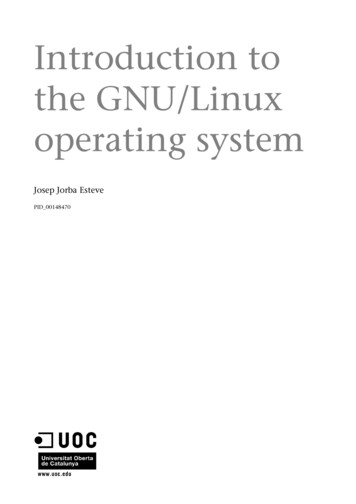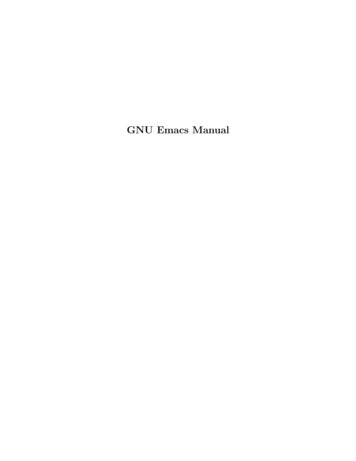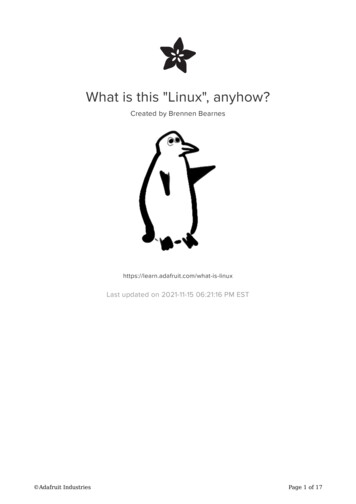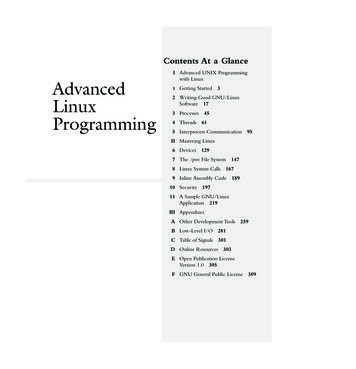
Transcription
Introduction tothe GNU/Linuxoperating systemJosep Jorba EstevePID 00148470
GNUFDL PID 00148470Copyright 2009, FUOC. Permission is granted to copy, distribute and/or modify this document under the terms of the GNU FreeDocumentation License, Version 1.2 or any later version published by the Free Software Foundation; with no Invariant Sections,no Front-Cover Texts, and no Back-Cover Texts. A copy of the license is included in the section entitled "GNU Free DocumentationLicense"Introduction to the GNU/Linux operating system
GNUFDL PID 00148470Introduction to the GNU/Linux operating systemIndexIntroduction.51.Free Software and Open Source.72.UNIX. A bit of history.133.GNU/Linux systems.214.The profile of the systems administrator.255.Tasks of the administrator.306.GNU/Linux distributions.356.1.Debian .396.2.Fedora Core .42What we will look at.47Activities.51Bibliography.527.
GNUFDL PID 001484705IntroductionGNU/Linux systems [Joh98] are no longer a novelty; they have a broad rangeof users and they are used in most work environments.Their origin dates back to August 1991, when a Finnish student called LinusTorvalds announced on a news list that he had created his own operatingsystem and that he was offering it to the community of developers for testingand suggesting improvements to make it more usable. This was the origin ofthe core (or kernel) of the operating system that would later come to be knownas Linux.Separately, the FSF (Free Software Foundation), through its GNU project, hadbeen producing software that could be used for free since 1984. Richard Stallman (FSF member) considered free software that whose source code we couldobtain, study, modify and redistribute without being obliged to pay for it. Under this model, the business does not reside in hiding the code, but rather inthe complementary additional software, tailoring the software to clients andadded services, such as maintenance and user training (the support we give)whether in the form of materials, books and manuals, or training courses.The combination of the GNU software and the Linux kernel, is what hasbrought us to today's GNU/Linux systems. At present, the open source movements, through various organisations, such as the FSF, and the companiesthat generate the different Linux distributions (Red Hat, Mandrake, SuSe.),including large companies that offer support, such as HP, IBM or Sun, havegiven a large push to GNU/Linux systems to position them at a level of beingcapable of competing and surpassing many of the existing closed proprietarysolutions.GNU/Linux systems are no longer a novelty. GNU software started in the mideighties, the Linux kernel, in the early nineties. And Linux is based on testedUNIX technology with more than 30 years of history.In this introductory unit we will revise some of the general ideas of the OpenSource and Free Software movements, as well as a bit of the history of Linuxand its shared origins with UNIX, from which it has profited from more than30 years of research into operating systems.Introduction to the GNU/Linux operating system
GNUFDL PID 0014847071. Free Software and Open SourceUnder the movements of Free Software and Open Source [OSIc] [OSIb] (alsoknown as open code or open software), we find various different forms ofsoftware that share many common ideas.A software product that is considered to be open source implies as itsmain idea that it is possible to access its source code, and to modifyit and redistribute it as deemed appropriate subject to a specific opensource license that defines the legal context.As opposed to a proprietary type code, whereby the manufacturer (softwarecompany) will lock the code, hiding it and restricting the rights to it to itself,without allowing the possibility of any modification or change that has notbeen made previously by the manufacturer, open source offers:a) access to the source code, whether to study it (ideal for education purposes)or to modify it, to correct errors, to adapt it or to add more features;b) software that is free of charge: normally, the software, whether in binaryform or source code form, can be obtained free of charge or for a modest sumto cover packaging and distribution costs and added value;c) standards that prevent monopolies of proprietary software, avoiding dependency on a single choice of software manufacturer; this is more important fora large organisation, whether a company or a state, which cannot (or shouldnot) put itself in the hands of a single specific solution and depend exclusivelyupon it;d) a model of progress that is not based on hiding information but on sharingknowledge (like the scientific community) so as to progress more rapidly, andwith better quality since decisions are based on the community's consensusand not on the whims of the companies that develop proprietary software.Creating programs and distributing them together with the source code isnothing new. Since the beginnings of IT and the Internet, things had beendone this way. However, the concept of open source itself, its definition andthe drafting of the conditions it has to meet date back to the middle of 1997.Introduction to the GNU/Linux operating system
GNUFDL PID 001484708Eric Raymond and Bruce Perens promoted the idea. Raymond [Ray98] wasthe author of an essay called The Cathedral and the Bazaar, which discussessoftware development techniques used by the Linux community, headed byLinus Torvalds, and the GNU community of the Free Software Foundation(FSF), headed by Richard Stallman. Bruce Perens was the leader of the Debianproject, which was working on creating a GNU/Linux distribution that integrated exclusively free software.NoteTwo of the most important communities are the FSF, with its GNU software project, andthe Open Source community, with Linux as its major project. GNU/Linux is the outcomeof their combined work.An important distinction between these communities lies in the definitionsof open source and free software. [Deba] [PS02]The Free Software Foundation [FSF] is a non-profit corporation founded byRichard Stallman, who believes that we should guarantee that programs arewithin everyone's reach free of charge, freely accessible and for use as eachindividual sees fit. The term free caused some reticence among companies.In English, the word can mean "without cost or payment" or "not under thecontrol or in the power of another". The FSF sought both, but it was difficultto sell these two ideas to businesses; the main question was: "How can wemake money with this?" The answer came from the Linux community (headedby Linus Torvalds), when they managed to obtain something that the GNUand FSF community had not yet achieved: a free operating system with anavailable source code. It was at that moment that the community decided tounite the various activities within the free software movement under a newname: open source software.Open Source was registered as a certification brand, to which software products complying with its specifications could adhere. This did not please everybody and there tends to be a certain divide or controversy over the twogroups of Open Source and FSF (with GNU), although really they have morethings in common than not.To some extent, for the exponents of free software (such as the FSF), opensource is a false step, because it means selling out its ideals to the market,leaving the door open for software that was free to become proprietary. Thosewho back open source see it as an opportunity to promote software that wouldotherwise only be used by a minority, whereas through its worldwide diffusionand sharing, including with companies wishing to participate in open source,we find sufficient strength to challenge proprietary software.Introduction to the GNU/Linux operating systemNoteSee The Catedral and theBazaar text at:http://www.catb.org/ esr/writings/cathedral-bazaar/cathedral-bazaar/
GNUFDL PID 001484709Introduction to the GNU/Linux operating systemHowever, the idea pursued by both movements is to increase the use offree software, thus offering an alternative to the sole solutions that largecompanies wish to impose. The differences are more than practical.Having established the basic ideas of the open source community, we reachedthe point where we needed to clarify the criteria a software product shouldmeet in order to qualify as open source. We had to base it on the definition ofopen source [OSIb] that was originally written by Bruce Perens in June 1997in response to comments by developers of the Debian Linux distribution,which was subsequently re-edited (with minor changes) by the Open SourceInitiative organisation (OSI). This body is responsible for controlling the opensource definition and licenses.NoteOpen source is regulated by a public definition used as the basis for drafting its softwarelicenses.A small summary (interpretation) of the definition: Open source software [OSIb], or software with an open source code, must fulfil the following requirements:1) The software may be copied, given away or sold to third parties, withoutrequiring any payment for it.2) The program must include source code and must allow distribution insource code as well as in compiled form. Or, in all events, there must be awell-publicised means of obtaining the source code (such as downloading viathe Internet, for example). Deliberately obfuscated or intermediary forms ofsource code are not allowed. The license must guarantee that changes can bemade.3) The software license must allow modifications and derived works, and mustallow them to be distributed under the same terms as the license of the originalsoftware. It allows the original code to be re-used.4) The integrity of the author's source code may be required, in other words,modifications may be presented in the form of patches to the original code, ormay be required to carry a different name or version number from the original.This protects which modifications can be attributed to the author. This pointdepends on what the software license says.5) The license must not discriminate against any person or group of persons.Access to the software must not be restricted. In some cases there may be legalrestrictions, as in the case of the United States for technology exports to thirdcountries. If there are restrictions of this type, they must be mentioned.NoteSee the original definition ofOpen Source at:http://www.opensource.org/docs/definition.phpIn re-edition at:http://www.opensource.org
GNUFDL PID 0014847010Introduction to the GNU/Linux operating system6) No discrimination against fields of endeavour. The software can be used inany field of endeavour, even if it was not designed for that field. Commercialuse is allowed; nobody can stop the software from being used for commercialpurposes.7) The license applies to everyone who receives the program.8) If the software forms part of a larger product, it must keep the same license.This makes sure that parts are not separated in order to form proprietary software (in an uncontrolled manner). In the case of proprietary software, it mustinform that it contains parts (stating which parts) of open source software.9) The license must not restrict any incorporated or jointly distributed software, in other words, its incorporation should not act as a barrier for anotherjointly distributed software product. This is a controversial issue since it appears to contradict the preceding point, basically it says that anyone can takeopen source software and add it to their own software without this affectingits license conditions (for example proprietary), although, according to thepreceding point, it would have to inform that there are parts of open source.10) The license must be technology neutral, i.e. not restricted to certain devices or operating systems. It is not allowed to mention exclusive distributionmeans or to exclude possibilities. For example, under the open source licence,it is not possible to restrict the distribution to CD, FTP or web form.This definition of open source is not a software license in itself, butrather a specification of the requirements that an open source softwarelicense must fulfil.In order to be considered an open source program, the program's license mustcomply with the above specifications. The OSI is responsible for checking thatlicences meet the specifications. On the Open Source Licenses web page youcan find the list of licenses [OSIa], of which one of the most famous and extensively used is the GPL (GNU Public License).Under the GPL, the software may be copied and modified, but modificationsmust be made public under the same license, and it prevents the code becoming mixed with proprietary code so as to avoid proprietary code taking overparts of open source. There is the LGPL license, which is practically identicalexcept that software with this license can be integrated into proprietary software. A classic example is the Linux C library (with LGPL license); if it wereGPL, only free software could be developed, with the LGPL it can be used fordeveloping proprietary software.NoteOpen Source html
GNUFDL PID 0014847011Many free software projects, or with part open source and part proprietarycode, have their own license: Apache (based on BSD), Mozilla (MPL and NPLof Netscape) etc. Basically, when it comes to identifying the software as opensource we can make our own license that complies with the above definition(of open source) or we can choose to license it under an already establishedlicense, or in the case of GPL, we are obliged for our license also to be GPL.Having studied the concepts of open source and its licenses, we need to lookat to what extent it is profitable for a company to work on or produce opensource. If it were not attractive for companies, we would lose both a potentialclient and one of the leading software producers at the same time.Open source is also attractive for companies, with a business model that emphasises a product's added value.Open source offers various attractive benefits where companies are concerned:a) For software developer companies, it poses a problem: how to make moneywithout selling a product. A lot of money is spent on developing a programand then profit has to be made on top. Well, there is no simple answer, it is notpossible with any type of software, the return lies in the type of software thatcan generate profit beyond the mere sale. Normally, a study will be made asto whether the application will become profitable if developed as open source(most will), based on the premises that we will have a reduced developmentcost (the community will help us), a reduced cost of maintenance or bug correction (the community can help with this quite quickly) and taking into account the number of users that the open source will provide, as well as theneeds that they will have for our support or documentation services. If thebalance is positive, then it will be viable to do without revenue from sales.b) Increasing the number of users.c) Obtaining greater development flexibility, the more people who intervene,the more people will be able to detect errors.d) Revenue will mostly come from support, user training and maintenance.e) Companies that use software need to take many parameters into consideration before choosing a software for managing tasks, such as performance,reliability, security, scalability and financial cost. And although it would seemthat open source is already an evident choice on the cost basis, we must saythat there is open source software capable of competing with (or even surpassing) proprietary software on any other parameter. Also, we need to takecare with choosing the options or proprietary systems of a single manufacturer; we cannot rely solely on them (we may recall cases such as Sony's betaformat video versus VHS, or the MicroChannel architecture of IBM for PCs).Introduction to the GNU/Linux operating system
GNUFDL PID 0014847012Introduction to the GNU/Linux operating systemWe need to avoid using monopolies with their associated risks: lack of pricecompetition, expensive services, expensive maintenance, little (or no) choiceof options etc.f) For private users it offers a large variety of software adapted for commonuses, since a lot of the software has been conceived and implemented by people who wanted to do the same tasks but could not find the right software.Usually, in the case of a domestic user, a very important parameter is the software cost, but the paradox is that precisely domestic users are more prone tousing proprietary software. Normally, domestic users will use illegal copies ofsoftware products; recent statistics show levels of 60-70% of illegal domesticcopies. Users feel that merely by owning a home PC they are entitled to usingthe software in some countries for it. In these cases, we are dealing with illegal situations, which although they may not have been prosecuted, may beone day, or are attempted to be controlled through license systems (or product activations). Also, this has an indirect negative effects on free software,because if users are extensively using proprietary software, it forces everyonewho wants to communicate them, whether banks, companies or public administrations, to use the same proprietary software too, and they do have topay the product licenses. One of the most important battles for free softwareis to capture domestic users.g) Finally, states, as a particular case, can obtain important benefits from opensource software, since it offers them quality software at ridiculous prices compared to the enormous cost of licenses for proprietary software. Moreover,open source software can easily integrate cultural aspects (of each country)such as language, for example. This last case is fairly problematic, since manufacturers of proprietary software refuse to adapt their applications in someregions – small states with their own language – or ask to be paid for doing so.NoteIllegal domestic copies are alsosometimes known as piratedcopies.
GNUFDL PID 0014847013Introduction to the GNU/Linux operating system2. UNIX. A bit of historyAs a predecessor to our GNU/Linux systems [Sta02], let's recall a bit about thehistory of UNIX [Sal94] [Lev]. Originally, Linux was conceived as a Minix clone(an academic implementation of UNIX for PC) and used some ideas developedin proprietary UNIX; but, in turn, it was developed in open source, and witha focus on domestic PCs. In this section on UNIX and in the following oneon GNU/Linux, we will see how this evolution has brought us to current dayGNU/Linux systems that are capable of competing with any proprietary UNIXand that are available for a large number of hardware architectures, from thesimple PC to supercomputers.Linux can be used on a broad range of machines. In the TOP500 list,we can find several supercomputers with GNU/Linux (see list on webpagetop500.org): for example, the MareNostrum, in the Barcelona SupercomputingCenter, a cluster, designed by IBM, with 10240 CPUs PowerPC with GNU/Linux operating system (adapted to the requirements of these machines). Fromthe list we can see that overall supercomputers with GNU/Linux make up 75%of the list.UNIX started back in 1969 (we now have almost 40 years of history) in theBell Telephone Labs (BTL) of AT&T. These had just withdrawn from a projectcalled MULTICS, which was designed to create an operating system so that alarge computer could support thousands of users simultaneously. BTL, GeneralElectric, and MIT were involved in the project. But it failed, in part, becauseit was too ambitious for the time.While this project was underway, two BTL engineers who were involved inMULTICS: Ken Thompson and Dennis Ritchie, found a DEC PDP7 computerthat nobody was using, which only had an assembler and a loading program.Thompson and Ritchie developed as tests (and often in their free time) partsof UNIX, an assembler (of machine code) and the rudimentary kernel of theoperating system.That same year, in 1969, Thompson had the idea of writing a file system forthe created kernel, in such a way that files could be stored in an ordered formin a system of hierarchical directories. Following various theoretical debates(which took place over about two months) the system was implemented injust a couple of days. As progress was made on the system's design, and afew more BTL engineers joined in, the original machine became too small,and they thought about asking for a new one (in those days they cost about100,000 US dollars, which was a considerable investment). They had to makeNoteWe can see the TOP500 list ofthe fastest supercomputers at:http://www.top500.org
GNUFDL PID 0014847014Introduction to the GNU/Linux operating systemup an excuse (since the UNIX system was a free time development) so theysaid they wanted to create a new text processor (an application that generatedmoney at that time), so they were given approval to purchase a PDP11.UNIX dates back to 1969, with over 30 years of technologies developedand used on all types of systems.When the machine arrived, they were only given the CPU and the memory,but not the disk or the operating system. Thompson, unable to wait, designeda RAM disk in memory and used half of the memory as a disk and the otherhalf for the operating system that he was designing. Once the disk arrived,they continued working on both UNIX and the promised text processor (theexcuse). The text processor was a success (it was Troff, an editor language subsequently used for creating the UNIX man pages), and BTL started using therudimentary UNIX with the new text processor, with BTL thus becoming thefirst user of UNIX.At that time, the UNIX philosophy started to emerge [Ray02a]: Write programs that do one thing and do it well. Write programs to work together. Write programs to handle text streams.Another important characteristic was that UNIX was one of the first systemsconceived to be independent of the hardware architecture, and this has allowed it to be carried over to a large number of different hardware architectures.In November 1971, as there were external users, the need to document whatwas being done resulted in the UNIX Programmer's Manual signed by Thompson and Richie. In the second edition (June 1972), known as V2 (the editionof the manuals was made to correspond with the UNIX version number), itwas said that the number of UNIX installations had already reached 10. Andthe number continued to grow to about 50 in V5.Then, at the end of 1973, it was decided to present the results at a conferenceon operating systems. And consequently, various IT centres and universitiesasked for copies of UNIX. AT&T did not offer support or maintenance to UNIX,which meant that users had to unite and share their knowledge by formingcommunities of UNIX users. AT&T decided to cede UNIX to universities, butdid not offer them support or correct errors for them. Users started sharingtheir ideas, information on programs, bugs etc. They created an associationcalled USENIX, meaning users of UNIX. Their first meeting in May 1974 wasattended by a dozen people.NoteSee: http://www.usenix.org
GNUFDL PID 0014847015One of the universities to have obtained a UNIX license was the University ofCalifornia at Berkeley, where Ken Thompson had studied. In 1975, Thompsonreturned to Berkeley as a teacher bringing with him the latest version of UNIX.Two recently-graduated students, Chuck Haley and Bill Joy (nowadays oneof the vice-presidents of SUN Microsystems), joined him and started to worktogether on a UNIX implementation.One of the first things that they were disappointed with were the editors; Joyperfected an editor called EX, until transforming it into VI, a full screen visualeditor. And the two developed a Pascal language compiler, which they addedto UNIX. There was a certain amount of demand for this UNIX implementation, and Joy started to produce it as the BSD, Berkeley Software Distribution(or UNIX BSD).BSD (in 1978) had a particular license regarding its price: it said that it corresponded to the cost of the media and the distribution it had at that time. Thus,new users ended up making some changes or incorporating features, sellingtheir remade copies and after a certain amount of time, these changes wereincorporated into the following version of BSD.Joy also made a few more contributions to his work on the vi editor, suchas handling text terminals in such a way that the editor was independent ofthe terminal where it was being used; he created the TERMCAP system as ageneric terminals interface with controllers for each specific terminal, so thatprograms could be executed irrespective of the terminals using the interface.The following step was to adapt it to different architectures. Until 1977, itcould only be run on PDP machines; that year adaptations were made formachines of the time such as Interdata and IBM. UNIX Version 7 (V7 in June1979) was the first portable one. This version offered many advances, as itincluded: awk, lint, make, uucp; the manual already had 400 pages (plus twoappendices of 400 pages each). It also included the C compiler designed at BTLby Kernighan and Ritchie, which had been created to rewrite most of UNIX,initially in the assembler and then into C with the parts of the assemblerthat only depended on the architecture. Also included were an improved shell(Bourne shell) and commands such as: find, cpio and expr.The UNIX industry also started to grow, and versions of UNIX (implementations) started to appear from companies such as: Xenix, a collaboration between Microsoft – which in its early days it also worked with UNIX versions– and SCO for Intel 8086 machines (the first IBM PC); new versions of BSDfrom Berkeley.Introduction to the GNU/Linux operating system
GNUFDL PID 0014847016However, a new problem appeared when AT&T realised that UNIX was a valuable commercial product, the V7 license prohibited its study in academic institutions in order to protect its commercial secret. Until that time many universities used the UNIX source code in order to teach operating systems, andthey stopped using it to teach only theory.However, everyone found their own way of solving the problem. In Amsterdam, Andrew Tanenbaum (prestigious author of theory books on operatingsystems) decided to write a new UNIX-compatible operating system withoutusing a single line of AT&T code; he called this new operating system Minix.This is what would subsequently be used in 1991 by a Finnish student to create his own version of UNIX, which he called Linux.Bill Joy, who was still at Berkeley developing BSD (already in version 4.1), decided to leave to a new company called SUN Microsystems, where he finishedworking on BSD 4.2, which would later be modified to create SUN's UNIX,SunOS (around 1983). Every company started developing its own versions:IBM developed AIX, DEC - Ultrix, HP - HPUX, Microsoft/SCO - Xenix etc. Asof 1980, UNIX began as a commercial venture, AT&T released a final versioncalled UNIX System V (SV), on which as well as on the BSD 4.x, current UNIXare based, whether on the BSD or the System V branch. SV was revised severaltimes and, for example, SV Release 4 was one of the most important ones. Theresult of these latest versions was that more or less all existing UNIX systemswere adapted to each other; in practice they are versions of AT&T's SystemV R4 or Berkeley's BSD, adapted by each manufacturer. Some manufacturersspecify whether their UNIX is a BSD or SV type, but in reality they all have abit of each, since later several UNIX standards were drawn up in order to tryand harmonise them; among these, we find IEEE POSIX, UNIX97, FHS etc.Over time, the UNIX system split into several branches, of which the two mainones were AT&T's UNIX or System V, and the University of California's BSD.Most current UNIX systems are based on one or the other, or are a mixtureof the two.However, at that time, AT&T (SVR4) was undergoing legal proceedings as atelephone monopoly (it was the leading, if not the only, telephone companyin the US), which forced it to split into several smaller companies, causingthe rights to UNIX to start dancing between owners: in 1990 it was shared50/50 by the Open Software Foundation (OSF) and UNIX International (UI),later, UNIX Systems Laboratories (USL), which denounced the University ofBerkeley for its BSD copies, but lost, since the original license did not imposeany ownership rights over the UNIX code. Later, the rights to UNIX were soldto Novell, which ceded a share to SCO, and as of today it is not very clear whoowns them: they are claimed through different fronts by Novell, the OSF andSCO. A recent example of this problem is the case of SCO, which initiated alawsuit against IBM because according to SCO, it had ceded parts of the UNIXsource code to versions of the Linux kernel, which allegedly include someIntroduction to the GNU/Linux operating system
GNUFDL PID 0014847017original UNIX co
system and that he was offering it to the community of developers for testing and suggesting improvements to make it more usable. This was the origin of the core (or kernel) of the operating system that would later come to be known as Linux. Separately, the FSF











